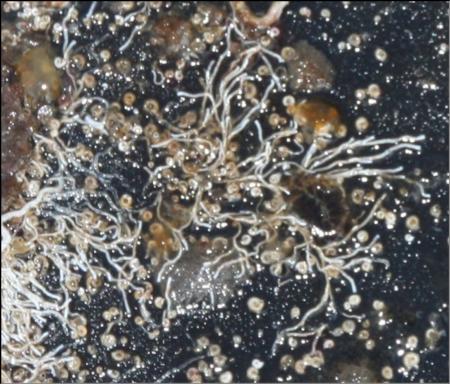Lacy Tube Worm
-
Scientific Name
Filograna implexa - Visit ITIS for full scientific classification.
-
Description
 Filograna implexa (in foreground). Photo by Carrie Culver © 2008 Regents, University of California.
Filograna implexa (in foreground). Photo by Carrie Culver © 2008 Regents, University of California.- Small, tube-dwelling, marine worm.
- Forms long, very thin, white calcareous (chalk-like) tubes in dense aggregations.
- Pinkish-grey colored bodies.
- When viewed under a microscope, body segments and feather-like tentacles can be seen.
-
Habitat
- Occurs in subtidal and low intertidal areas.
- Like other tubeworms it encrusts hard surfaces including: rocks, shells, other marine animals, vessel hulls, piers, etc.
-
Invasion Pathways and Distribution
- Spread by attaching to vessel hulls, from which larvae swim to settle on surfaces in marinas.
- Found worldwide, including in California.
-
Life History
- Filter-feeder; uses feather-like gill tentacles to capture particles in the water.
- Reproduces asexually by budding or sexually by releasing sperm and eggs into the water, where they unite to form swimming larvae.
-
Impacts
- The chalky tubes form crusts on boat hulls.
- This fouling growth roughens the hull’s surface, creating friction or “drag” that slows sailboats and increases fuel consumption for powerboats.
- Tolerant of copper in antifouling paint, and are very difficult to remove.
-
References and Useful Links
For references by category and links to other useful AIS sites see our LEARN MORE page.

